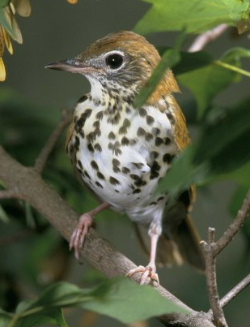There are all sorts of creatures that make incredible journeys around the world between winter feeding grounds and summer breeding areas. And now there is a new group of birds that has joined the ranks of the long-distance endurance flyers: the songbirds.
 For the first time scientists have been able to mount tiny tracking devices on these little birds and gather data on the huge journeys they undertake from the United States down to Central and South America.
For the first time scientists have been able to mount tiny tracking devices on these little birds and gather data on the huge journeys they undertake from the United States down to Central and South America.
Bridget Stutchbury from York University in Toronto, Canada led a team of scientists who attached tiny geo-locators onto 14 wood thrushes and 20 purple martins at their breeding grounds in Pennsylvania in the US in 2007.
Then in 2008 the team retrieved the tracking devices from five thrushes and two martins and from the data collected they found out where the bird flew and how long it took them
The geo-locators work by measuring light levels so the researchers could estimate the birds' latitude and longitude by recording the time of sunrises and sunsets.
The team found that the songbirds can fly over three hundred miles a day, an astonishing odyssey for birds that are so small and presumably can't carry with them large energy stores. Wood thrushes have a wingspan of about 30cm and weigh around 45g, and purple martins are a similar size.
They also found that these birds fly over six times faster in the spring when they return to the US compared to in winter when they fly south.
This sort of information is crucial for understanding more about the life cycle of songbirds which have been declining around the world for decades. It will also to help gauge how much these birds are likely to be affected by environmental problems like habitat loss and climate change.
- Previous Sing a song of distance
- Next Cure for the common cold?










Comments
Add a comment